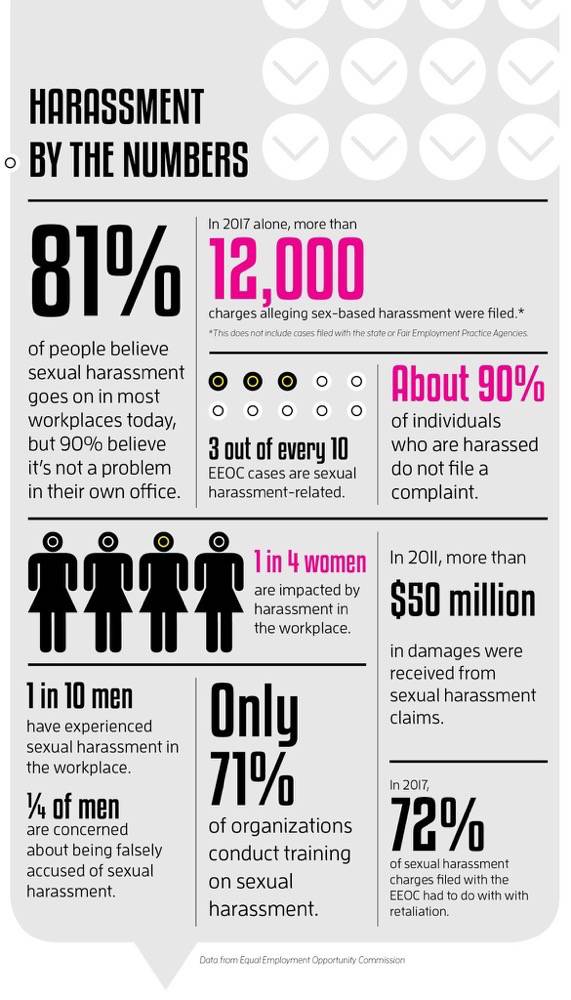Photo by Hillary Ehlen
With high-profile conversations taking place over the past year on workplace harassment — a.k.a. the #MeToo Movement — it’s important to understand that the topic is relevant not just in Hollywood but here in our market as well. In my inaugural piece for Fargo INC!, I’ll be covering some harassment basics and discussing some prevention methods and possible courses of action to take if you ever encounter harassment in your own workplace.
6 Things To Know
- Harassment has ripple effects that go well beyond an individual incident.
Harassment not only has financial and reputational impact for employers; it also has a significant impact on employees’ emotional and financial well-being. If it’s allowed to flourish, employers can expect to see an increase in turnover and use of sick time and decreased productivity.
- Help employees help themselves.
A good place for employers to start is to provide awareness and education to their team members on what harassment in the workplace is and what they should do if they need to file a complaint or grievance. Empower your employees to speak up, and make it clear that witnesses need to act and that it’s everyone’s responsibility.
- It’s often more than just the victim who’s affected by harassment.
Whether it’s a fellow employee, a victim’s supervisor, another supervisor in a different area, or even a non-employee such as a consultant or client, many others can be affected by guilt, fear, poor morale and other forms of emotional stress caused by harassment.
- It’s important to advocate for yourself.
People are not mind-readers and therefore might not know what bothers us and what we find offensive.
- Harassment can be subjective.
Whether or not something is construed as harassment can depend on how someone interprets an action or comment. Further, how we interpret a situation can be altered by our sleep, stress, mood or any number of other things. So when in doubt: Don’t say or do it, and ask yourself, “Would I say this to my grandma?”
It’s also important to note that people can become offended by things based on what has affected them in the past. It’s not necessarily because they’re weak or don’t have a sense of humor but because of their life experiences.
- Harassment inquiries are on the rise.
As it’s become a priority for more and more organizations, our organization, the Fargo Moorhead Human Resource Association, has received an increased volume of requests for tools and knowledge related to the topic of harassment.
6 Things To Do
- Know your employee handbook.
Your handbook is more than just something that tells employees when they get a day off or how to get a raise; it’s a resource for them to know how to get help from your company. On top of that, really get to know your HR team. They are a valued resource and can really help develop your employees.
- Employers should provide their team with a clear and detailed anti-harassment policy.
Clarify workplace-conduct expectations and reduce risk by taking precautions, being proactive and regularly evaluating your policies.
- Educate and bring further awareness through training.
Be aware that check-the-box training will not be impactful. Let employees be self-aware and understand what inappropriate behavior is and how to identify a situation of harassment. Limit the focus on the legal burdens — as it’s not the point — and instead focus on how creating the right behaviors will create a healthier environment and lead to a better culture.
- Design and implement an internal, anonymous complaint system.
Don’t forget to train your users on the process and on a system for tracking, if you choose to implement one. When designing, incorporate your mission, vision and values as a part of your decision process.
- Communicate that harassment should be reported at an early stage to prevent escalation.
When employees do file a report, acknowledge complaints, respond carefully, investigate quickly and discipline accordingly.
- Always practice zero tolerance.
A policy will only get you so far, especially if you don’t follow it. The first step in taking action is to not let bad behavior be overlooked or let it slide for any reason, even if it’s from a top performer, donor, investor or senior leader.
Also, support your employees who come forward, and use a similar zero-tolerance policy for retaliation.
What Is The FMHRA?
The Fargo Moorhead Human Resource Association is an affiliate chapter of the Society for Human Resources and was established in 1976. With membership composed of HR professionals, business owners, and organizational leaders, they host nearly 30 events each year and partner with several organizations to offer professional development opportunities for their chapter members.
They host three conferences per year (spring, fall and summer) and partner with the state of North Dakota on the Governor’s Workforce & HR Conference that’s held each September. They also offer a mentorship program for their 400 active members.
Some Upcoming FMHRA Events
“Mental Health for HR Professionals”
Wednesday, June 7, 1-4 p.m.
Speaker: FirstLink
“When Religion and Work Collide”
Tuesday, July 10, 11:30 a.m. – 1 p.m.
Speaker: Cynthia Bremer/David McKinney
“Get Ready for Gen. Z”
Tuesday, July 17, 3:30-4:30 p.m.
Speakers: Heather, Ethan and Adam Ostrowski

Village Institute’s Robert Jones contributed to this piece.
Brenda Johnson is president-elect of the Fargo Moorhead Human Resource Association. She’ll be contributing regularly to Fargo INC!, discussing all things HR.








